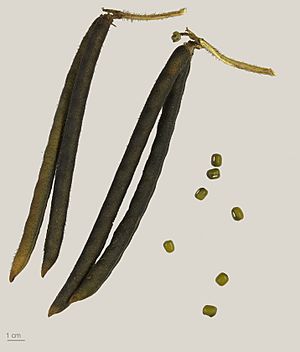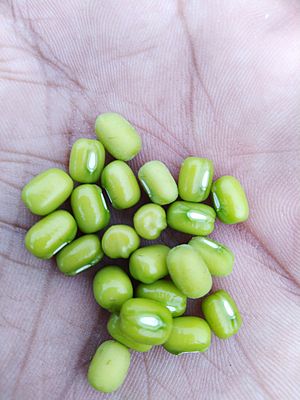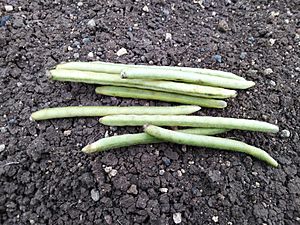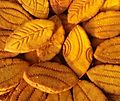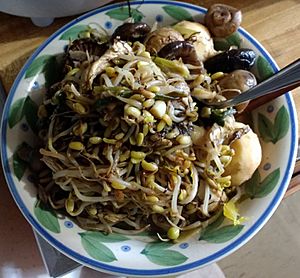Mung bean facts for kids
Quick facts for kids Mung bean |
|
|---|---|
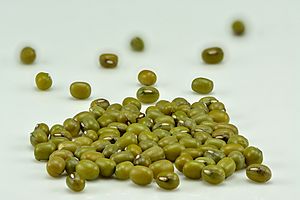 |
|
| Mung beans | |
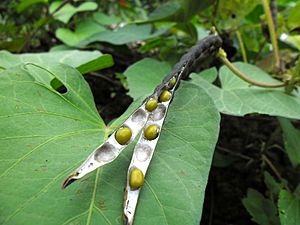 |
|
| Dried and opened mung bean pod | |
| Scientific classification | |
| Genus: |
Vigna
|
| Species: |
radiata
|
| Synonyms | |
|
|
| Nutritional value per 100 g (3.5 oz) | |
|---|---|
| Energy | 1,452 kJ (347 kcal) |
|
62.62 g
|
|
| Sugars | 6.6 g |
| Dietary fiber | 16.3 g |
|
1.15 g
|
|
|
Protein
|
28.86 g
|
| Vitamins | Quantity
%DV†
|
| Thiamine (B1) |
54%
0.621 mg |
| Riboflavin (B2) |
19%
0.233 mg |
| Niacin (B3) |
14%
2.251 mg |
| Pantothenic acid (B5) |
38%
1.91 mg |
| Vitamin B6 |
29%
0.382 mg |
| Folate (B9) |
156%
625 μg |
| Vitamin C |
6%
4.8 mg |
| Vitamin E |
3%
0.51 mg |
| Vitamin K |
9%
9 μg |
| Minerals | Quantity
%DV†
|
| Calcium |
13%
132 mg |
| Iron |
52%
6.74 mg |
| Magnesium |
53%
189 mg |
| Manganese |
49%
1.035 mg |
| Phosphorus |
52%
367 mg |
| Potassium |
42%
1246 mg |
| Zinc |
28%
2.68 mg |
|
Link to USDA Database entry
|
|
| †Percentages estimated using US recommendations for adults. | |
| Nutritional value per 100 g (3.5 oz) | |
|---|---|
| Energy | 126 kJ (30 kcal) |
|
5.94 g
|
|
| Sugars | 4.13 g |
| Dietary fiber | 1.8 g |
|
0.18 g
|
|
|
Protein
|
3.04 g
|
| Vitamins | Quantity
%DV†
|
| Thiamine (B1) |
7%
0.084 mg |
| Riboflavin (B2) |
10%
0.124 mg |
| Niacin (B3) |
5%
0.749 mg |
| Pantothenic acid (B5) |
8%
0.38 mg |
| Vitamin B6 |
7%
0.088 mg |
| Folate (B9) |
15%
61 μg |
| Vitamin C |
16%
13.2 mg |
| Vitamin E |
1%
0.1 mg |
| Vitamin K |
31%
33 μg |
| Minerals | Quantity
%DV†
|
| Calcium |
1%
13 mg |
| Iron |
7%
0.91 mg |
| Magnesium |
6%
21 mg |
| Manganese |
9%
0.188 mg |
| Phosphorus |
8%
54 mg |
| Potassium |
5%
149 mg |
| Zinc |
4%
0.41 mg |
|
Link to USDA Database entry
|
|
| †Percentages estimated using US recommendations for adults. | |
| Nutritional value per 100 g (3.5 oz) | |
|---|---|
| Energy | 441 kJ (105 kcal) |
|
19.15 g
|
|
| Sugars | 2 g |
| Dietary fiber | 7.6 g |
|
0.38 g
|
|
|
Protein
|
7.02 g
|
| Vitamins | Quantity
%DV†
|
| Thiamine (B1) |
14%
0.164 mg |
| Riboflavin (B2) |
5%
0.061 mg |
| Niacin (B3) |
4%
0.577 mg |
| Pantothenic acid (B5) |
8%
0.41 mg |
| Vitamin B6 |
5%
0.067 mg |
| Folate (B9) |
40%
159 μg |
| Vitamin C |
1%
1 mg |
| Vitamin E |
1%
0.15 mg |
| Vitamin K |
3%
2.7 μg |
| Minerals | Quantity
%DV†
|
| Calcium |
3%
27 mg |
| Iron |
11%
1.4 mg |
| Magnesium |
14%
48 mg |
| Manganese |
14%
0.298 mg |
| Phosphorus |
14%
99 mg |
| Potassium |
9%
266 mg |
| Zinc |
9%
0.84 mg |
|
Link to USDA Database entry
|
|
| †Percentages estimated using US recommendations for adults. | |
The mung bean (Vigna radiata), alternatively known as the green gram, maash (Persian: ماش), moong (from Sanskrit: मुद्ग, romanized: mudga), monggo, or munggo (Philippines), is a plant species in the legume family. The mung bean is mainly cultivated in East Asia, Southeast Asia and the Indian subcontinent. It is used as an ingredient in both savoury and sweet dishes.
Contents
Description
The green gram is an annual vine with yellow flowers and fuzzy brown pods.
The English word mung originated (and used as is) from the Hindi word मूंग ("moong"), which is derived from the Sanskrit word मुद्ग ("mudga").
Taxonomy
Mung beans are one of many species moved from the genus Phaseolus to Vigna in the 1970s. The previous names were Phaseolus aureus or P. radiatus.
Uses
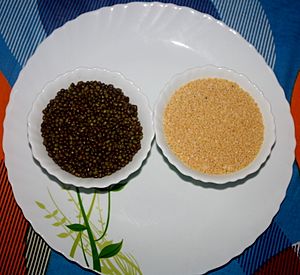
Mung beans are commonly used in cuisines across Asia.
Whole beans and paste
Whole cooked mung beans are generally prepared from dried beans by boiling until they are soft. Mung beans are light yellow in colour when their skins are removed. Mung bean paste can be made by hulling, cooking, and pulverizing the beans to a dry paste.
South Asia
Although whole mung beans are also occasionally used in Indian cuisine, beans without skins are more commonly used. In Karnataka, Maharashtra, Gujarat, Kerala and Tamil Nadu, whole mung beans (called pachai payaru (பச்சை பயறு) in Tamil, cherupayar (ചെറുപയർ) in Malayalam, pesalu (పెసలు) in Telugu and hesaru kaalu (ಹೆಸರು ಕಾಳು) in Kannada) are commonly boiled to make a dry preparation often served with rice gruel (kanji கஞ்சி). It is called mūṅg (मूँग) in Hindi. In Sri Lanka, it is called mun (මුං) in Sinhala. Hulled mung beans can also be used in a similar fashion as whole beans for the purpose of making sweet soups.
Summer Moong is a short duration mung bean pulse crop grown in northern India. Due to its short duration, it can fit well inbetween of many cropping systems. It is mainly cultivated in East and Southeast Asia and the Indian subcontinent. It is considered to be the hardiest of all pulse crops and requires a hot climate for germination and growth.
Mung beans in some regional cuisines of India are stripped of their outer coats to make mung dal. In Bangladesh and West Bengal the stripped and split bean is used to make a soup-like dal known as moog dal (মুগ ডাল).
In the South Indian states of Karnataka, Tamil Nadu, Telangana and Andhra Pradesh, and also in Maharashtra, steamed whole beans are seasoned with spices and fresh grated coconut in a preparation called "pesalu" పెసలు in Telugu or usuli or guggari in Kannada or sundal சுண்டல் in Tamil or "usal" उसळ in Marathi. In South India, especially Andhra Pradesh, batter made from ground whole moong beans (including skin) is used to make a variety of dosa called pesarattu or pesara dosa. The same is called Adai Dosai in Tamil Nadu and ade dose in Karnataka.
East Asia
In Chinese cuisine, whole mung beans are used to make a tángshuǐ, or dessert, otherwise literally translated ‘sugar water’, called lǜdòu tángshuǐ, which is served either warm or chilled. They are also often cooked with rice to make congee. Unlike in South Asia, whole mung beans seldom appear in savory dishes.
In Hong Kong, hulled mung beans and mung bean paste are made into ice cream or frozen ice pops. Mung bean paste is used as a common filling for Chinese mooncakes in East China and Taiwan. During the Dragon Boat Festival, the boiled and shelled beans are used as filling in zongzi 粽子 glutinous rice dumplings prepared for consumption. The beans may also be cooked until soft, blended into a liquid, sweetened, and served as a beverage, popular in many parts of China. In south China and Vietnam, mung bean paste may be mixed with sugar, fat, and fruits or spices to make pastries, such as Bánh đậu xanh.
In Korea, skinned mung beans are soaked and ground with some water to make a thick batter. This is used as a basis for the Korean pancakes called bindae-tteok (Hangul: {녹두}빈대떡).
Southeast Asia
In the Philippines, ginisáng monggó (sautéed mung bean stew), also known as monggó guisado or balatong, is a savoury stew of whole mung beans with prawns or fish. It is traditionally served on Fridays of Lent, when the majority Catholic Filipinos traditionally abstain from meat. Variants of ginisáng monggó may also be made with chicken or pork.
Mung bean paste is also a common filling of pastries known as hopia (or bakpia) popular in Indonesia, the Philippines and further afield in Guyana (where it is known as ”black eye cake”). In Indonesia, mung beans are also made into a popular dessert snack called es kacang hijau, which has the consistency of a porridge. The beans are cooked with sugar, coconut milk, and a little ginger.
Middle East
A staple diet in some parts of the Middle East is mung beans and rice. Both are cooked together in a pilaf-like rice dish called maash wa ruzz, which means mung beans and rice.
-
Ginisang monggo with ampalaya and shrimp
-
Hopia filled with mung bean paste
-
Korean mung bean pancakes (Hangul: 빈대떡) being cooked
-
Mung pakon, traditional Bengali pitha, Bangladesh.
Bean sprouts
Mung beans are germinated by leaving them in water for four hours of daytime light and spending the rest of the day in the dark. Mung bean sprouts can be grown under artificial light for four hours over the period of a week. They are usually simply called "bean sprouts". However, when bean sprouts are called for in recipes, it generally refers to mung bean or soybean sprouts.
Mung bean sprouts are stir-fried as a Chinese vegetable accompaniment to a meal, usually with garlic, ginger, spring onions, or pieces of salted dried fish to add flavour. Uncooked bean sprouts are used in filling for Vietnamese spring rolls, as well as a garnish for phở. They are a major ingredient in a variety of Malaysian and Peranakan cuisine, including char kway teow, hokkien mee, mee rebus, and pasembor.
In Korea, slightly cooked mung bean sprouts, called sukjunamul (Hangul: 숙주나물), are often served as a side dish. They are blanched (placed into boiling water for less than a minute), immediately cooled in cold water, and mixed with sesame oil, garlic, salt, and often other ingredients. In the Philippines, mung bean sprouts are made into lumpia rolls called lumpiang togue.
In India, mung bean sprouts are cooked with green chili, garlic, and other spices.
In Indonesia the food are often used as fillings like tahu isi (stuffed tofu) and complementary ingredient in many dishes such as rawon and soto.
In Japan (and Brazil), the sprouts are called moyashi.
Starch
Mung bean starch, which is extracted from ground mung beans, is used to make transparent cellophane noodles (also known as bean thread noodles, bean threads, glass noodles, fensi (Chinese: 粉絲), tung hoon (Chinese: 冬粉), miến, bún tàu, or bún tào). Cellophane noodles become soft and slippery when they are soaked in hot water. A variation of cellophane noodles, called mung bean sheets or green bean sheets, are also available.
In Korea, a jelly called nokdumuk (Hangul: 녹두묵; also called cheongpomuk; Hangul: 청포묵) is made from mung bean starch; a similar jelly, colored yellow with the addition of gardenia coloring, is called hwangpomuk (Hangul: 황포묵).
In northern China, mung bean jelly is called liangfen (Chinese: 涼粉; literally "chilled bean jelly"), which is a very popular food during summer. The Hokkiens add sugar to mung bean jelly to make it a dessert called Lio̍k-tāu hún-kóe (Chinese: 綠豆粉粿; literally "mung bean flour cake").
Mung batter is used to make crepes named pesarattu in Andhra Pradesh, India and pancakes named bindaetteok in Korea. (The starch content is around 56.82%.)
Plant-based protein
Mung beans are increasingly used in plant-based meat and egg alternatives such as Beyond Meat and Just Egg.
History of domestication and cultivation
The mung bean was domesticated in India, where its progenitor (Vigna radiata subspecies sublobata) occurs wild.
Carbonized mung beans have been discovered in many archeological sites in India. Areas with early finds include the eastern zone of the Harappan Civilisation in modern-day Pakistan and western- and northwestern India, where finds date back about 4,500 years, and South India in the modern state of Karnataka where finds date back more than 4,000 years. Some scholars, therefore, infer two separate domestications in the northwest and south of India. In South India, there is evidence for the evolution of larger-seeded mung beans 3,500 to 3,000 years ago. By about 3500 years ago mung beans were widely cultivated throughout India.
Cultivated mung beans later spread from India to China and Southeast Asia. Archaeobotanical research at the site of Khao Sam Kaeo in southern Thailand indicates that mung beans had arrived in Thailand by at least 2,200 years ago.
Images for kids
-
Sichuan-style spicy liangfen
See also
 In Spanish: Vigna radiata para niños
In Spanish: Vigna radiata para niños


